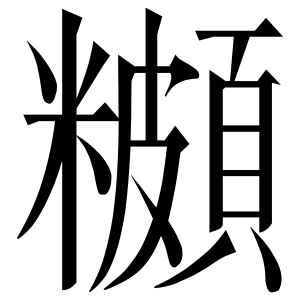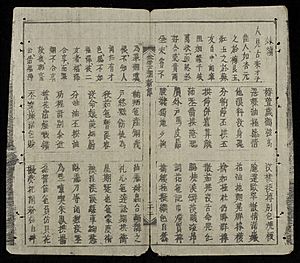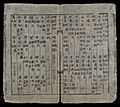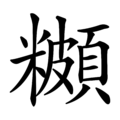Nôm facts for kids
Quick facts for kids Nôm |
|
|---|---|

This is the Nôm character for rice noodle soup, or phở, a popular dish in Vietnam. The radical for this character is 米 (meaning rice) and the remainder is 頗. A radical classifies a character by meaning while a remainder indicates pronunciation.
|
|
| Vietnamese name | |
| Vietnamese | chữ Nôm |
| Hán-Nôm | 字喃 |
Nôm was an old writing system used in Vietnam. It used Chinese characters to write the Vietnamese language. The oldest known example of Nôm writing is on the Van Ban bell, made in 1076. The oldest surviving Nôm books are from the 13th century. People used Nôm often until the 1920s. Then, it was replaced by the Vietnamese alphabet, which is a form of the Latin alphabet.
Contents
What is Nôm?
For a long time, the Vietnamese royal court and government used Classical Chinese for official documents. The Temple of Literature in Hanoi was a famous school where people studied Chinese. Scholars who knew Chinese often thought Nôm was not as good. However, most ordinary people liked Nôm. Only a few people could read any language back then, but almost every village had someone who could read Nôm.
In Nôm, a Vietnamese word could be written using a Chinese character that had a similar meaning or sound. Each character shows an idea, like a picture for a word. These are called "ideographs." Also, each character stands for a syllable, which is a sound. Because of this, almost every sound in modern Vietnamese has a meaning. Like Chinese, Vietnamese is a tonal language. This means the way you say a word (the tone) changes its meaning.
Over time, the Vietnamese alphabet took over from Nôm. Unlike alphabets in other places, the Vietnamese alphabet has special marks to show tones. Today, students in Vietnam do not have to learn the old Nôm characters. Only a small number of experts around the world can read Nôm now. Old Vietnamese books written in Nôm, like Tale of Kieu, can mostly only be read in translated versions. But, writing characters beautifully (calligraphy) is still popular for home decorations and good luck. The Han-Nom Institute, started in 1970, collects and studies old Nôm writings. In 2001, Nôm characters were added to Unicode, which is a worldwide system for computer text.
How Nôm Characters Work
Chinese characters are used to write many languages, like Mandarin (the most spoken language in China) and Cantonese (spoken in Hong Kong). They were also used in Korea and Vietnam. Japan uses a mix of Chinese characters and its own sound-based writing. Even if characters mean the same thing in different languages, they can be read differently. For example, the character 十 means "ten" in many languages. It's read shí in Chinese, jū in Japanese, sip in Korean, and thập in Vietnamese.
Building Nôm Characters
Most Nôm characters came from Chinese. They were often made by combining a part that shows meaning with a part that shows sound. For example, the character "喃" is read as "Nôm". It has a sound part "南" (which sounds like Naam4 in Cantonese) and means "chattering." The word "Nôm" in Vietnamese does not mean anything bad; it just means "plain talk" or something easy to understand.
Nôm also has thousands of characters that are not found in Chinese. These characters were made by Vietnamese writers. They put together existing parts. One part, called the semantic component, shows the character's meaning. The other part, called the phonetic component, shows how to say it. For example, the sound ba can be shown by the character 巴. In Vietnamese, to write "three" (which is ba), they added the character for "three" (三) as the meaning part, making 𠀧 (⿺巴三). For "father" (also ba), they added the character for "father" (父), making 爸 (⿱父巴).
About half of the 9,299 Nôm characters are unique to Vietnam. Each Nôm character has a special code in Unicode.
| Nôm Characters | |||||||||
|---|---|---|---|---|---|---|---|---|---|
| Character | Meaning Part | Sound Part | Reading | English | Found in Chinese? | Unicode Code | Source | Total in set | |
| 𠊚 | 人 | 㝵 | người | people | No | U+2029B | V0 | 2,246 | |
| 𤤰 | 王 | 布 | vua | king | No | U+24930 | |||
| 妖 | 女 | 夭 | yêu | to love | Yes | U+5996 | V1 | 3,311 | |
| 越 | 走 | 戉 | Việt | Vietnamese | Yes | U+8D8A | |||
| 𠶡 | 口 | 𥐧 | trối | dying wish | No | U+20DA1 | V2 | 3,205 | |
| 㐱 | 人 | 彡 | chỉn or xỉn | Used in bủn xỉn (stingy) | Yes | U+3431 | |||
| 𡮲 | 小 | 詩 | thơ | early childhood | No | U+21BB2 | V3 | 535 | |
| 𧹼 | 赤 | 都 | đỏ | red | No | U+27E7C | |||
| Key: "Found in Chinese?" means if the character is also used in modern Chinese. | |||||||||
Nôm's History in Vietnam
Chinese characters came to Vietnam after the Han Empire took over in 111 BC. Vietnam became independent in 939, but they kept using the Chinese writing system for official things. Around 1010, Vietnamese people started using Chinese characters to write their own language. The Van Ban bell from 1076 is the oldest known Nôm writing.
Many Nôm documents were destroyed by the Chinese during their rule from 1407 to 1428. Famous writers like Nguyen Trai (1380–1442) wrote in both Chinese and Nôm. In the 17th century, Trinh Thi Ngoc Truc created a huge dictionary that translated Chinese to Vietnamese using Nôm.
Unlike Chinese, Nôm was not studied in a very organized way for most of its history. Vietnamese writers who knew Chinese used Chinese writing rules for their own language. Even though official records were usually in Chinese, Nôm was used by two short-lived dynasties. King Minh Mang (1820-1841) did not like Nôm. But in 1838, Jean-Louis Taberd wrote a Nôm dictionary that became very popular. In 1867, a Catholic scholar asked King Tu Duc to use Nôm instead of Classical Chinese for official use. The king didn't agree, but he did try to promote Nôm.
Nôm in Daily Life
In the 19th century, many popular books and poems were written in Nôm. These included famous works like Nguyen Du's The Tale of Kieu and the poetry of Ho Xuan Huong. Even though only a small part of the population (3 to 5 percent) could read, almost every village had someone who could read Nôm aloud for everyone else.
In Korea and Japan, their traditional writing systems were made simpler so more people could learn them. But in Vietnam, educated people often thought Nôm was not as good as Chinese. So, they didn't work to make Nôm simpler or more standard for everyone to use.
The Shift to the Vietnamese Alphabet
In the late 1800s, the French rulers in Vietnam started to promote the Vietnamese alphabet. They saw it as a way for Vietnamese people to learn French more easily. Other Asian countries were also changing their languages, which made Vietnamese people interested too. After the Russo-Japanese War in 1905, Japan was seen as a good example of a modern Asian country.
Vietnamese nationalists liked the alphabet because it was seen as the "national language" (quốc ngữ). They thought it would help more people learn to read and write. They compared the old Chinese-based education system to Japan's public schools and found it lacking. A nationalist writer named Phan Boi Chau told young people to "study in the East," meaning Japan.
In 1910, the French school system started using a "Franco-Vietnamese curriculum," which focused on French and the Vietnamese alphabet. Teaching Chinese characters stopped in 1917. On December 28, 1918, King Khai Dinh announced that the old writing system was no longer official. The last civil service exam, which tested knowledge of Chinese, was held on January 4, 1919. This exam system had been in place for almost 900 years.
By the 1920s, the Vietnamese alphabet became the main writing system in the country. By the 1930s, Nôm was mostly used only in special books for Buddhist monks. More recently, Nôm characters are mainly used in calligraphy, like for wedding decorations.
Most Common Nôm Characters
Here are twenty-five of the most common characters found in Nôm literature. The modern Vietnamese spelling is shown in italics.
- 羅 là to be
- 吧 và and
- 各 các each; every
- 没 một one
- 固 có there is
- 𧵑 của of
- 得 được to get
- 𥪝 trong in
- 𤄯 trong clear
- 𠊛 or 𠊚 người people
- 忍 những (plural marker)
- 學 học to learn
- 如 như as
- 詞 từ word
- 會 hội to meet
- 咍 hay or; good
- 空 không not
- 体 thể body
- 四 tư four
- 拱 cũng also
- 𠇍 với with
- 朱 cho to give
- 社 xã society, company
- 尼 này, nơi place
- 底 để to place
Images for kids
-
The Nôm character for phở, a popular soup. The left part (米) means rice, showing the meaning. The right part (頗) shows the sound.
See also
 In Spanish: Chữ Nôm para niños
In Spanish: Chữ Nôm para niños








